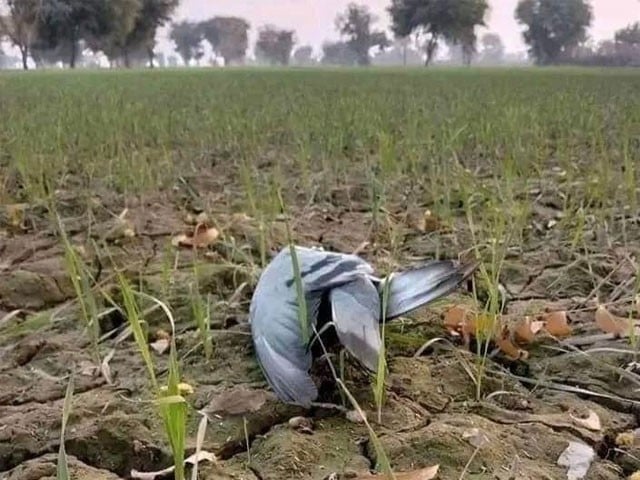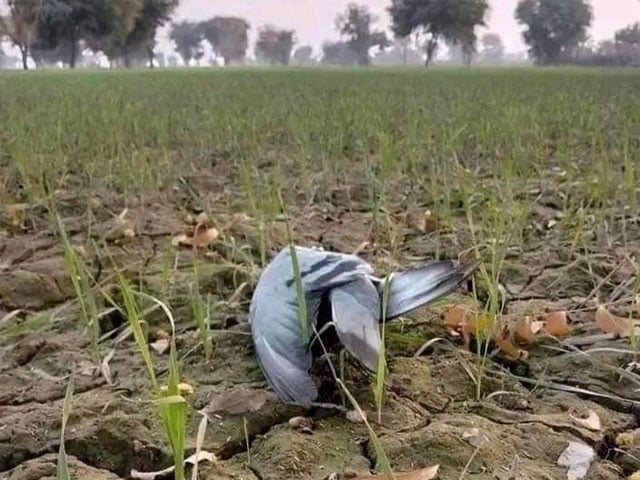
Hazardous chemicals from poisons and fertilizers also affect the reproductive capacity of wildlife.
Lahore: Due to the use of poisons and chemical fertilizers for the cultivation of crops, dozens of birds of different species are becoming extinct.
Experts say that the dangerous chemicals of poisons and fertilizers are not only causing the death of wildlife but also affecting their reproductive capacity.
Integrated pest management and organic fertilizers have to be used to save wildlife. In a survey conducted in 1965, 240 species of birds were seen in Lahore and its suburbs, but now there are only 74 species.
Farmers use various poisons and chemical fertilizers for more and better production from crops and gardens. In this way, the production is increasing, but the chirping birds, many eco-friendly insects, insects, moths and animals are disappearing in the fields and gardens.
Mian Abdul Rauf is a resident and zamindar of Manhala, a border area of Lahore. They say that the use of poisons and chemical fertilizers has become a necessity to protect the crops from various diseases and to produce more from the land. Their forefathers used to use animal waste and garbage as fertilizers to increase the productivity of the fields, but when different agricultural drugs and chemical fertilizers came in the market, the farmers started using them.
It was done in 1965 to know the types of birds found in Lahore and its surroundings. A survey by the Department of Zoology, Punjab University found 140 bird species, while a 1992 survey found 101 birds.
Similarly, in the survey conducted in 1997 under the auspices of Government College Lahore, 74 types of birds were seen. In this review, 44 birds were local and 30 were migratory. Among the migratory birds, 17 in winter and 13 in summer came here. Among them are common sparrow, golden sparrow, quail, red-backed bulbul, parrots, woodpeckers, murres, black partridges, brown partridges, quails, hummingbirds, herons, myna, white-cheeked bulbuls, ram sparrows, kingfishers, fakhta, lalians, indigo. Crows, eagles, crows, vultures, owls, sharks, pigeons and bats are notable.
According to the experts, one of the main reasons for the extinction of these birds is the use of poisons and chemical fertilizers on crops and gardens.
Prof. Dr. Zulfikar Ali says seeds, fertilizers and pesticides soaked in chemical poisons actually pose significant threats to birds and wildlife. Chemicals used in fertilizers and pesticides are often toxic. Birds and wildlife ingest these substances directly or indirectly from contaminated food or water sources.
These poisons and chemical fertilizers kill insects, fungi and other insects immediately. Some pesticides contain endocrine-disrupting chemicals that not only affect the reproductive capacity of birds, but also cause their death.
Prof. Dr. Zulfikar Ali also said that chemicals used in agriculture affect wildlife through the food chain. Birds and wildlife eat insects or plants affected by these poisons and chemical fertilizers and then feed these insects to other animals, then these toxic substances are transferred to them. Similarly, runoff from agricultural areas can carry pesticides and fertilizers into nearby water bodies, polluting aquatic ecosystems.
It can harm fish and other aquatic life. This is the reason why the use of poisons and chemical fertilizers in crops and gardens is affecting our ecosystem.
According to Dr Zulfiqar Ali, to reduce these risks and promote environmentally friendly practices, it is important for farmers and gardeners to consider alternative, sustainable methods of pest control and fertilization. Integrated pest management, organic farming practices, and non-toxic fertilizers must be used.
Punjab Agriculture Department Director General (Extension) Dr. Anjum Ali Butar while talking to Express Tribune said that agricultural drugs used in Pakistan are 100% imported. All over the world, such agricultural drugs that harm plants, birds, animals and the environment are banned. Therefore, such agricultural drugs cannot be imported. He said that damage occurs when these agricultural drugs and chemical fertilizers are used indiscriminately and unnecessarily.
Dr. Anjam Ali Butar says that the major problem in food production for Pakistan at this time is not quality but quantity. Therefore, agricultural drugs and chemical fertilizers are used not only in Pakistan but also in all those countries whose GDP depends on the export of agricultural products to achieve maximum production.
He said there are four methods of destroying harmful weeds and insects from crops. The first method is to destroy the weeds by hand, the second method is the method of Godi, the third method is the elimination of dangerous insects with the help of friendly insects and the last option is agricultural drugs and chemical fertilizers. He said that the use of fertilizers and poisons needs to be done with utmost responsibility. The Department of Agriculture guides the farmers in this regard and literature is distributed.
Mudassar Hasan, Focal Person of Punjab Wildlife, told The Express Tribune that no campaign was ever conducted at the central level in this regard, nor was there any contact with the farmers and the Department of Agriculture not to use such poisonous sprays and chemical fertilizers in the crops and gardens. which may cause harm to birds and other wildlife, however, all Divisional Deputy Directors of Wildlife conduct awareness campaigns in their areas and inform the farmers about the harmful effects of using agricultural drugs and chemical fertilizers.
(function(d, s, id){
var js, fjs = d.getElementsByTagName(s)[0];
if (d.getElementById(id)) {return;}
js = d.createElement(s); js.id = id;
js.src = “//connect.facebook.net/en_US/sdk.js#xfbml=1&version=v2.3&appId=770767426360150”;
fjs.parentNode.insertBefore(js, fjs);
}(document, ‘script’, ‘facebook-jssdk’));
(function(d, s, id) {
var js, fjs = d.getElementsByTagName(s)[0];
if (d.getElementById(id)) return;
js = d.createElement(s); js.id = id;
js.src = “//connect.facebook.net/en_GB/sdk.js#xfbml=1&version=v2.7”;
fjs.parentNode.insertBefore(js, fjs);
}(document, ‘script’, ‘facebook-jssdk’));



